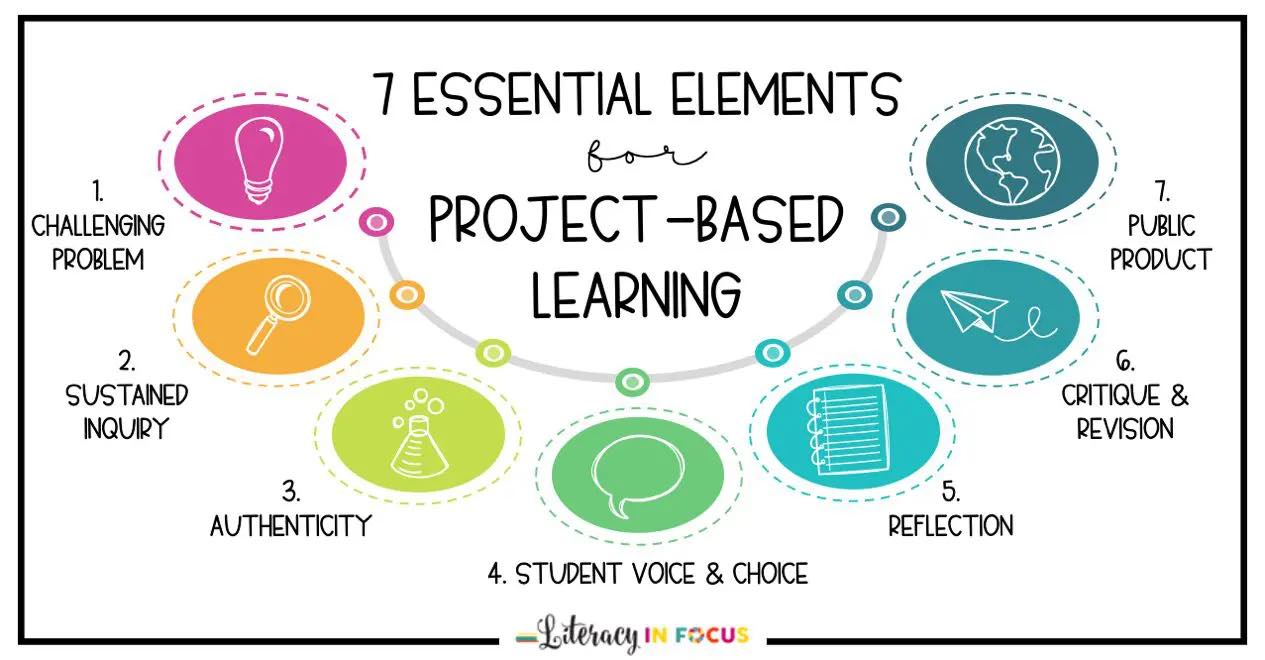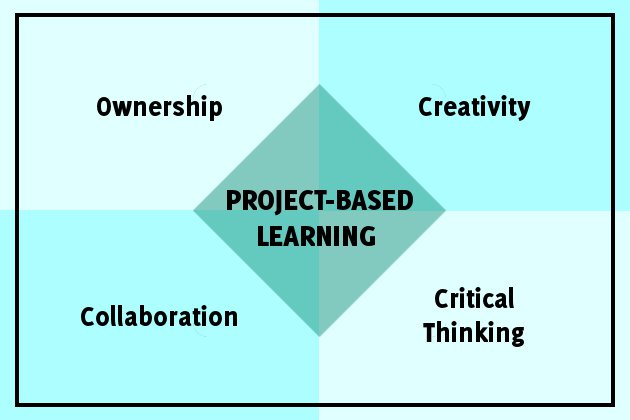Project-Based Learning
Empower students with Project-Based Learning. Dive deep into inquiry, foster critical thinking, and enhance content knowledge effectively.


Empower students with Project-Based Learning. Dive deep into inquiry, foster critical thinking, and enhance content knowledge effectively.
Project-Based Learning (PBL) is an educational approach where students actively explore real-world problems, putting them at the center of their own learning journey. Instead of passively receiving information, students gain deep content knowledge and essential skills by investigating and responding to complex questions, problems, or challenges over an extended period. PBL, as a form of inquiry-based learning, encourages students to take ownership, fostering independence and a deeper understanding of the subject matter.
In PBL, learning is active, students don’t just memorize facts, they construct their knowledge by engaging in meaningful activities. They investigate a central theme or problem, applying research, critical thinking, and problem-solving to create a final product or presentation. For example, a history class could explore the causes and effects of a major historical event. Students might analyze primary and secondary sources, engage in discussions, and even conduct interviews or site visits. Their work could culminate in a multimedia presentation, a report, or a debate that demonstrates their understanding.
As "Give the pupils something to do, not something to learn; and the doing is of such a nature as to demand thinking." This reflects the pedagogical approach of PBL, it’s about doing and thinking, not just absorbing information. Students are challenged to make connections, ask questions, and reflect on their learning, leading to genuine understanding.
This article aims to unpack the evidence behind PBL, exploring why it works and how it can lead to significant learning gains. We will also provide educators with practical guidance on how to facilitate PBL in their classrooms, including strategies for supporting student learning, ensuring they can harness its full potential to engage students deeply. Whether you're new to PBL or looking to refine your approach, this guide will help you create a classroom environment where active learning thrives.
Project-based learning differs from traditional teaching by placing students at the center of their learning journey through active exploration of real-world problems. Instead of passively receiving information, students construct knowledge by investigating complex questions and challenges over extended periods. This approach transforms students from passive learners into critical thinkers who take ownership of their education.
Project Based Learning (PBL) is an instructional method used to teach students concepts and skills. PBL is a student-centered approach to teaching that focuses on problem-solving, critical thinking, collaboration, and communication skills. In a traditional classroom environment, there is a greater emphasis on teachers presenting information and expecting students to memorize facts and then communicate their understanding through summative assessments.
However, in a PBL class, students learn material by working together to solve problems. Students are given assignments that force them to think critically and collaborate with others. They are expected to come to class prepared with questions and answers, rather than simply listening to lectures. Project Based Learning (PBL) is a teaching method that allows students to learn concepts and skills by working together on real world projects. PBL encourages collaboration and teamwork while allowing students to gain valuable experience outside of the classroom. Students are given a project that requires research, planning, execution, and evaluation.
This type of learning takes place over several weeks or months and culminates in a final presentation. During this time, students work closely with teachers and peers to develop solutions to problems and create products that demonstrate their knowledge. There are many benefits to PBL, including increased motivation and engagement, improved critical thinking skills, and greater creativity. Because students are required to complete a project, they are forced to put forth effort and focus on the task at hand. As a result, they become more invested in the outcome of the project and less likely to procrastinate.

PBL also provides opportunities for students to collaborate with each other. When students work together, they build relationships and trust among themselves and with their teacher. These connections allow students to share ideas and resources, giving them the opportunity to learn from each other. Because PBL is project focused, students have to plan and execute tasks independently. This gives them responsibility and ownership over their own education. They must manage their time effectively and prioritize assignments appropriately.
In addition, PBL promotes student autonomy and self-direction. Instead of being told what to do, students are encouraged to explore topics and solve problems on their own. They are responsible for finding answers and developing solutions to complex issues. Lastly, PBL helps students understand the value of feedback and reflection. Teachers provide immediate feedback during class discussions and give individualized feedback after every assignment. Students then reflect on their progress and evaluate their performance. Through this process, they learn to analyze their strengths and weaknesses and adjust their approach accordingly.
While PBL is beneficial for students, it can also benefit teachers. For example, teachers can spend more time focusing on instruction rather than administration. Additionally, teachers can monitor student progress more easily since they receive instant feedback. Finally, PBL can help teachers prepare for future lessons by providing them with insight into student thought processes. This type of education has been proven to improve academic performance and decrease dropout rates.
It might also beneficial for students who struggle with ADHD, dyslexia, and autism spectrum disorders.

Project-Based Learning (PBL) is sometimes used interchangeably with "experiential learning," but its characteristics are distinct and firmly rooted in the practical philosophy of John Dewey. While project parameters may differ between schools, the core features of PBL remain consistent. Below are the seven defining characteristics of the Project-Based or Experiential Learning Model:
Many often confuse project-based learning with problem-based learning, but there are key differences. In project-based learning, students produce a tangible artifact that demonstrates their mastery of content. On the other hand, in problem-based learning, the focus is on finding a solution to a clearly defined problem, emphasizing the process over the final product.

According to the Buck Institute for Education (BIE), Project-Based Learning (PBL) involves students actively exploring and responding to complex, engaging, and real-world problems. Based on 15 years of literature review and distilled academic experience, the Buck Institute has outlined seven essential elements for effective PBL, often referred to as Gold Standard Project-Based Learning. These core elements provide a structure that ensures meaningful and impactful learning experiences for students:
When all these essential elements are combined effectively, they lead to deeper learning, better understanding, and the acquisition of key knowledge and skills that are crucial for success. Though PBL may initially seem like a specific or isolated teaching practice, incorporating these elements creates a robust framework that fosters great learning experiences for students.

Project-Based Learning provides significant benefits for students, teachers, and the broader school community. The approach goes beyond traditional memorization, encouraging students to engage with content deeply and apply their knowledge to real-world contexts. Below are some of the key advantages of PBL:
Overall, Project-Based Learning transforms the classroom into a dynamic environment where students are motivated, engaged, and equipped with the skills necessary for success in both school and life.

There are several types of projects that can be done in a PBL class. Here are three examples:
• Problem Solving Projects
These projects involve students working together to find solutions to real world problems. These projects usually include brainstorming, group discussion, and writing.
• Research Projects
Research projects allow students to explore topics that interest them. Students conduct research online, read books, watch videos, and talk to experts.
• Service Learning Projects
Service learning projects encourage students to give something back to society. Students may volunteer at a food pantry, tutor children, or provide tutoring services.
Despite the above challenges of PBL, the demands of the 21st century make one thing apparent i.e. the traditional pedagogical approach to learning is not sufficient to prepare children to face the challenges of the 21st century. It is not necessary to seek answers from books only. To implement PBL, schools may seek suggestions and opinions from students, parents, or teachers.
Also, the project can be made more manageable by performing in parts, with repeated checkpoints, rather than launching a massive project in a single attempt. It is suggested to take authentic assessments under the supervision of professionals, rather than a traditional summative In modern times it is essential to use project-based learning, because it is largely believed that we are living in a project-based world, where success depends upon the successful completion of a series of projects. At first, PBL may appear challenging but it can ultimately make the learning process much more interesting and engaging for students!
Project-based learning dramatically improves outcomes by giving students control over their learning journey, particularly benefiting SEND pupils and reluctant learners. Students develop deep content knowledge and essential skills through active engagement with meaningful activities rather than memorization. The approach fosters independence, critical thinking, and problem-solving abilities that prepare students for real-world challenges.
Project-Based Learning (PBL) extends beyond academic success, fostering a breadth of educational outcomes. Here are seven ways PBL nurtures wider educational development:
Incorporating these elements, teachers can use PBL as a dynamic platform to cultivate not just subject matter experts but well-rounded individuals equipped with the skills and mindsets to thrive beyond school walls.

To effectively introduce Project-based learning into your classroom, consider these seven key strategies:
By focusing on these elements, you can create a PBL environment that not only aligns with educational standards but also prepares students for the challenges and opportunities they will face after their school years.

Teachers can access additional project-based learning resources through educational research databases, professional development programs, and specialized PBL organizations. Key resources include implementation guides that outline the seven characteristics of powerful PBL and timing strategies for classroom success. These materials provide practical frameworks for transforming group work into meaningful project-based experiences.
Here are five key studies on the efficacy of project-based learning (PBL) and its implications for educational outcomes:
These studies collectively highlight the positive effects of project-based learning on student motivation, self-efficacy, teacher efficacy, and academic achievement, advocating for the integration of PBL strategies in educational settings to foster more engaging and effective learning experiences.
Project-Based Learning (PBL) is an educational approach where students actively explore real-world problems, putting them at the center of their own learning journey. Instead of passively receiving information, students gain deep content knowledge and essential skills by investigating and responding to complex questions, problems, or challenges over an extended period. PBL, as a form of inquiry-based learning, encourages students to take ownership, fostering independence and a deeper understanding of the subject matter.
In PBL, learning is active, students don’t just memorize facts, they construct their knowledge by engaging in meaningful activities. They investigate a central theme or problem, applying research, critical thinking, and problem-solving to create a final product or presentation. For example, a history class could explore the causes and effects of a major historical event. Students might analyze primary and secondary sources, engage in discussions, and even conduct interviews or site visits. Their work could culminate in a multimedia presentation, a report, or a debate that demonstrates their understanding.
As "Give the pupils something to do, not something to learn; and the doing is of such a nature as to demand thinking." This reflects the pedagogical approach of PBL, it’s about doing and thinking, not just absorbing information. Students are challenged to make connections, ask questions, and reflect on their learning, leading to genuine understanding.
This article aims to unpack the evidence behind PBL, exploring why it works and how it can lead to significant learning gains. We will also provide educators with practical guidance on how to facilitate PBL in their classrooms, including strategies for supporting student learning, ensuring they can harness its full potential to engage students deeply. Whether you're new to PBL or looking to refine your approach, this guide will help you create a classroom environment where active learning thrives.
Project-based learning differs from traditional teaching by placing students at the center of their learning journey through active exploration of real-world problems. Instead of passively receiving information, students construct knowledge by investigating complex questions and challenges over extended periods. This approach transforms students from passive learners into critical thinkers who take ownership of their education.
Project Based Learning (PBL) is an instructional method used to teach students concepts and skills. PBL is a student-centered approach to teaching that focuses on problem-solving, critical thinking, collaboration, and communication skills. In a traditional classroom environment, there is a greater emphasis on teachers presenting information and expecting students to memorize facts and then communicate their understanding through summative assessments.
However, in a PBL class, students learn material by working together to solve problems. Students are given assignments that force them to think critically and collaborate with others. They are expected to come to class prepared with questions and answers, rather than simply listening to lectures. Project Based Learning (PBL) is a teaching method that allows students to learn concepts and skills by working together on real world projects. PBL encourages collaboration and teamwork while allowing students to gain valuable experience outside of the classroom. Students are given a project that requires research, planning, execution, and evaluation.
This type of learning takes place over several weeks or months and culminates in a final presentation. During this time, students work closely with teachers and peers to develop solutions to problems and create products that demonstrate their knowledge. There are many benefits to PBL, including increased motivation and engagement, improved critical thinking skills, and greater creativity. Because students are required to complete a project, they are forced to put forth effort and focus on the task at hand. As a result, they become more invested in the outcome of the project and less likely to procrastinate.

PBL also provides opportunities for students to collaborate with each other. When students work together, they build relationships and trust among themselves and with their teacher. These connections allow students to share ideas and resources, giving them the opportunity to learn from each other. Because PBL is project focused, students have to plan and execute tasks independently. This gives them responsibility and ownership over their own education. They must manage their time effectively and prioritize assignments appropriately.
In addition, PBL promotes student autonomy and self-direction. Instead of being told what to do, students are encouraged to explore topics and solve problems on their own. They are responsible for finding answers and developing solutions to complex issues. Lastly, PBL helps students understand the value of feedback and reflection. Teachers provide immediate feedback during class discussions and give individualized feedback after every assignment. Students then reflect on their progress and evaluate their performance. Through this process, they learn to analyze their strengths and weaknesses and adjust their approach accordingly.
While PBL is beneficial for students, it can also benefit teachers. For example, teachers can spend more time focusing on instruction rather than administration. Additionally, teachers can monitor student progress more easily since they receive instant feedback. Finally, PBL can help teachers prepare for future lessons by providing them with insight into student thought processes. This type of education has been proven to improve academic performance and decrease dropout rates.
It might also beneficial for students who struggle with ADHD, dyslexia, and autism spectrum disorders.

Project-Based Learning (PBL) is sometimes used interchangeably with "experiential learning," but its characteristics are distinct and firmly rooted in the practical philosophy of John Dewey. While project parameters may differ between schools, the core features of PBL remain consistent. Below are the seven defining characteristics of the Project-Based or Experiential Learning Model:
Many often confuse project-based learning with problem-based learning, but there are key differences. In project-based learning, students produce a tangible artifact that demonstrates their mastery of content. On the other hand, in problem-based learning, the focus is on finding a solution to a clearly defined problem, emphasizing the process over the final product.

According to the Buck Institute for Education (BIE), Project-Based Learning (PBL) involves students actively exploring and responding to complex, engaging, and real-world problems. Based on 15 years of literature review and distilled academic experience, the Buck Institute has outlined seven essential elements for effective PBL, often referred to as Gold Standard Project-Based Learning. These core elements provide a structure that ensures meaningful and impactful learning experiences for students:
When all these essential elements are combined effectively, they lead to deeper learning, better understanding, and the acquisition of key knowledge and skills that are crucial for success. Though PBL may initially seem like a specific or isolated teaching practice, incorporating these elements creates a robust framework that fosters great learning experiences for students.

Project-Based Learning provides significant benefits for students, teachers, and the broader school community. The approach goes beyond traditional memorization, encouraging students to engage with content deeply and apply their knowledge to real-world contexts. Below are some of the key advantages of PBL:
Overall, Project-Based Learning transforms the classroom into a dynamic environment where students are motivated, engaged, and equipped with the skills necessary for success in both school and life.

There are several types of projects that can be done in a PBL class. Here are three examples:
• Problem Solving Projects
These projects involve students working together to find solutions to real world problems. These projects usually include brainstorming, group discussion, and writing.
• Research Projects
Research projects allow students to explore topics that interest them. Students conduct research online, read books, watch videos, and talk to experts.
• Service Learning Projects
Service learning projects encourage students to give something back to society. Students may volunteer at a food pantry, tutor children, or provide tutoring services.
Despite the above challenges of PBL, the demands of the 21st century make one thing apparent i.e. the traditional pedagogical approach to learning is not sufficient to prepare children to face the challenges of the 21st century. It is not necessary to seek answers from books only. To implement PBL, schools may seek suggestions and opinions from students, parents, or teachers.
Also, the project can be made more manageable by performing in parts, with repeated checkpoints, rather than launching a massive project in a single attempt. It is suggested to take authentic assessments under the supervision of professionals, rather than a traditional summative In modern times it is essential to use project-based learning, because it is largely believed that we are living in a project-based world, where success depends upon the successful completion of a series of projects. At first, PBL may appear challenging but it can ultimately make the learning process much more interesting and engaging for students!
Project-based learning dramatically improves outcomes by giving students control over their learning journey, particularly benefiting SEND pupils and reluctant learners. Students develop deep content knowledge and essential skills through active engagement with meaningful activities rather than memorization. The approach fosters independence, critical thinking, and problem-solving abilities that prepare students for real-world challenges.
Project-Based Learning (PBL) extends beyond academic success, fostering a breadth of educational outcomes. Here are seven ways PBL nurtures wider educational development:
Incorporating these elements, teachers can use PBL as a dynamic platform to cultivate not just subject matter experts but well-rounded individuals equipped with the skills and mindsets to thrive beyond school walls.

To effectively introduce Project-based learning into your classroom, consider these seven key strategies:
By focusing on these elements, you can create a PBL environment that not only aligns with educational standards but also prepares students for the challenges and opportunities they will face after their school years.

Teachers can access additional project-based learning resources through educational research databases, professional development programs, and specialized PBL organizations. Key resources include implementation guides that outline the seven characteristics of powerful PBL and timing strategies for classroom success. These materials provide practical frameworks for transforming group work into meaningful project-based experiences.
Here are five key studies on the efficacy of project-based learning (PBL) and its implications for educational outcomes:
These studies collectively highlight the positive effects of project-based learning on student motivation, self-efficacy, teacher efficacy, and academic achievement, advocating for the integration of PBL strategies in educational settings to foster more engaging and effective learning experiences.